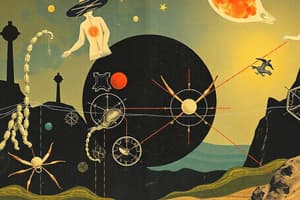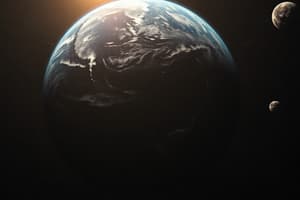Podcast
Questions and Answers
Cuál de las siguientes ideas contradice la teoría del creacionismo clásico?
Cuál de las siguientes ideas contradice la teoría del creacionismo clásico?
- Las especies pueden evolucionar a lo largo del tiempo. (correct)
- Las especies han permanecido sin cambios desde su origen.
- La vida fue creada de forma separada e independiente.
- La vida surgió por la voluntad de seres divinos.
¿Cómo refutó Louis Pasteur la teoría de la generación espontánea?
¿Cómo refutó Louis Pasteur la teoría de la generación espontánea?
- Probó que los microbios se originan de otros microorganismos preexistentes. (correct)
- Observó la formación espontánea de microbios en el barro.
- Demostró que los microbios solo se originan en materia no viva.
- Creó microorganismos a partir de elementos inertes en el laboratorio.
La teoría de la panspermia dirigida sugiere que la vida en la Tierra fue sembrada por:
La teoría de la panspermia dirigida sugiere que la vida en la Tierra fue sembrada por:
- Seres extraterrestres que buscaban colonizar nuevos planetas. (correct)
- Microorganismos generados espontáneamente en el espacio.
- Moléculas orgánicas complejas viajando en meteoritos.
- Impactos de asteroides ricos en carbono.
En el experimento de Miller, ¿qué compuestos se formaron al simular las condiciones de la Tierra primitiva y aplicar descargas eléctricas?
En el experimento de Miller, ¿qué compuestos se formaron al simular las condiciones de la Tierra primitiva y aplicar descargas eléctricas?
¿Cuál es el concepto central de la selección natural, como propuso Darwin?
¿Cuál es el concepto central de la selección natural, como propuso Darwin?
¿Qué evento marcó el límite entre la Era Mesozoica y la Era Cenozoica?
¿Qué evento marcó el límite entre la Era Mesozoica y la Era Cenozoica?
¿Qué característica distingue a los homínidos del resto de los primates, según la teoría de la evolución humana?
¿Qué característica distingue a los homínidos del resto de los primates, según la teoría de la evolución humana?
En la cosmovisión maya quiché del Popol Vuh, ¿qué material utilizaron los creadores para formar a los primeros hombres exitosos?
En la cosmovisión maya quiché del Popol Vuh, ¿qué material utilizaron los creadores para formar a los primeros hombres exitosos?
¿Qué implicación tuvo la formación del supercontinente Pangea en el desarrollo de la vida en la Tierra?
¿Qué implicación tuvo la formación del supercontinente Pangea en el desarrollo de la vida en la Tierra?
¿Qué evento característico del período Cuaternario tuvo un impacto significativo en la distribución de la vida en la Tierra?
¿Qué evento característico del período Cuaternario tuvo un impacto significativo en la distribución de la vida en la Tierra?
Flashcards
Creacionism
Creacionism
Attributes life's existence to an unknown force or the will of divine beings; reinforced by early cultures.
Spontaneous Generation
Spontaneous Generation
States that some living things originate from inert materials like mud or decaying meat.
Panspermia
Panspermia
Life's elements distributed throughout the universe, arriving on Earth via meteorites.
Oparin Theory
Oparin Theory
Signup and view all the flashcards
Fixism
Fixism
Signup and view all the flashcards
Intelligent Design
Intelligent Design
Signup and view all the flashcards
Natural Selection
Natural Selection
Signup and view all the flashcards
Phylogenetic Tree
Phylogenetic Tree
Signup and view all the flashcards
Precambrian Eon
Precambrian Eon
Signup and view all the flashcards
Holocene Epoch
Holocene Epoch
Signup and view all the flashcards
Study Notes
- There are multiple theories about the origin of life on Earth, including creationism, spontaneous generation, panspermia, and Oparin's theory.
Creationism
- It attributes the origin of life to an unknown force or the will of divine beings.
- This belief originated from primitive humans and was reinforced by early cultures like the Egyptian and Mesopotamian civilizations.
- Several branches exist, including classical creationism, fixism, and intelligent design
Classical Creationism
- Denies biological evolution and scientific evidence of the origin of life.
- Based on a literal interpretation of sacred texts.
Fixism
- Describes nature as a definite, unchangeable reality.
- According to fixism living beings have remained unchanged since creation.
- Formally developed in the 17th century by Carl Linnaeus, who stated that species were created separately and independently, denying a common origin.
Intelligent Design
- Argues that the origin of the universe and living beings is the result of deliberate, rational actions by one or more intelligent agents.
Spontaneous Generation
- It claims that some living beings can originate from inert materials like mud, sweat, or rotting meat.
- Aristotle supported this theory (384-322 BC)
- In the 17th century, Jean Baptiste van Helmont claimed mice could be created by wrapping wheat grains in a dirty, sweaty shirt and waiting 21 days.
- Francesco Redi (1626-1698) later disproved spontaneous generation showing it was wrong.
- In 1860, Louis Pasteur explained that microbes and spores caused the decomposition of organic matter, proving that all living beings come from other living beings.
Panspermia
- It suggests that the elements for the origin of life were distributed throughout the universe.
- They arrived on Earth via meteorites after being ejected from other planets due to volcanic eruptions or asteroid impacts.
- Anaxágoras (500 BC-428 BC) first proposed it in the 6th century BC.
- German biologist Hermann Richter defended the term panspermia, from Greek pan meaning all, and sperma meaning seed, in 1865
- Svante Arrhenius, Nobel Prize winner in Chemistry, popularized it in 1903.
- Nobel laureate Francis Crick and British astronomer Fred Hoyle supported Panspermia.
- Directed panspermia suggests intelligent beings controlled the process, seeding life where they chose.
- Molecular panspermia states that complex organic molecules are the material basis for the genesis of life.
Oparin's Theory
- Alexander Oparin proposed in 1924 the abiotic synthesis theory.
- The primitive environment of the seas, rich in electrical discharges, volcanic eruptions, and substances like oxygen, gas, methane, and hydrogen, combined to form organic compounds called coacervates.
- Coacervates are systems of diverse macromolecules that formed in aqueous conditions and evolved into cells and characteristics of living organisms.
- In the mid-20th century, Stanley Miller created a primitive soup simulating Oparin's proposed conditions and subjected it to electrical discharges.
- Miller found amino acids which are precursors to proteins forming the building blocks of organisms.
Theory of Evolution
- Charles Darwin explained his hypothesis of how today's animal and plant species are derived from similar passed species, in his book "The Origin of Species" (1859).
- Understanding of evolution requires considering geological events, climate changes, radiation of organisms to new habitats, changes in ecosystems, continental positions, and mass extinctions.
- Natural Selection: Continuous, gradual adaptation needed for survival.
- Phylogenetic tree: Shows evolution relationships among species that are believed to have a common ancestor.
- Human Evolution: Humans are descended from human-like apes.
Key milestones in the historyof life
- 4,600 million years ago: Earth forms and is bombarded by meteorites and comets.
- 3,800 million years ago: Replicating molecules, precursors of DNA, are created
- 3,500 million years ago: The unicellular life begin and phtosynthetic bacteria begin releasing Oxygen to the atmosphere
- 555 million years ago: Multicellular marine organisms where common, with strange looking animals
- 500 million years ago: vertebrated appeared like fish with invertebrates
- 450 million years ago: Arthropods colonize the terrestrial environment evolving into scorpions, spiders, mites and centipedes.
- 420 million years ago: Land plants evolve, dramatically changing Earth landscape and creating new habitats
- 360 million years ago: Tetrapodes vertebrates colonize The Earth where seeded plant and big wood appear with huge coral reef.
- 250 million years ago: Pangea supercontinent formed. Conifer-like tree forests, reptiles, and synapsids are the ancestors to mammals.
- 248 million years ago: most of the marine life and 70% on terrestrial life dissapear on the most important extinction on Earth with ammonites getting over the extinction
- 225 million years ago: Evolution of dinosaurs and mammals. Pangea strats breaking apart.
- 130 million years ago: Flowering plants appears while dinosaurs dominate the landscape
- 65 million years ago: Yucatán Peninsula asteroid impacted and the ammonites and non-avian dinosaurs went extinct with birds and mammals between survivors.
- 4 million years ago: In Africa, one of the first hominids, Lucy, lived where ice age began.
- 130 thousand years ago: Anatomical modern humans evolve.
- 70 thousand years ago: Descendants create paintings.
Mayan Quiché "Theory of Creation"
- The Popol Vuh explains the origins of the universe from a cultural perspective.
- Figure of the twin heroes, Hunaphú e Ixbalanqué,
- Three part classification of the content of Mayan creation
- Silcence is when The Earth has been bombarded by meteorites and comets.
- No man animal etc.
- The first men, how did they apear on the Land and relation with the gods.
- Hunahpú e Ixnalanqué is one of the source of Mayan culture that explains the origins of universe
- 4 human bodies are made on earth.
Studying That Suits You
Use AI to generate personalized quizzes and flashcards to suit your learning preferences.




